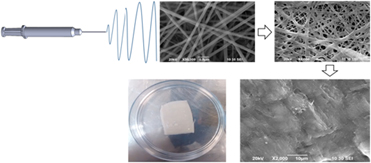Crossref Citations
This article has been cited by the following publications. This list is generated based on data provided by
Crossref.
Xu, Yongjing
Liu, Bo
Zou, Liming
Sun, Chenkai
and
Li, Wengang
2020.
Preparation and characterization of PLLA/chitosan-graft-poly (ε-caprolactone) (CS-g-PCL) composite fibrous mats: The microstructure, performance and proliferation assessment.
International Journal of Biological Macromolecules,
Vol. 162,
Issue. ,
p.
320.
Terrell, John A.
Jones, Curtis G.
Kabandana, Giraso Keza Monia
and
Chen, Chengpeng
2020.
From cells-on-a-chip to organs-on-a-chip: scaffolding materials for 3D cell culture in microfluidics.
Journal of Materials Chemistry B,
Vol. 8,
Issue. 31,
p.
6667.
Muniz, Nathália O.
Vechietti, Fernanda A.
Anesi, Guilherme R.
Guinea, Gustavo V.
and
dos Santos, Luís Alberto L.
2020.
Blend-based fibers producedviacentrifugal spinning and electrospinning processes: Physical and rheological properties.
Journal of Materials Research,
Vol. 35,
Issue. 21,
p.
2905.
Kumar, Pawan
Saini, Meenu
Dehiya, Brijnandan S.
Sindhu, Anil
Kumar, Vinod
Kumar, Ravinder
Lamberti, Luciano
Pruncu, Catalin I.
and
Thakur, Rajesh
2020.
Comprehensive Survey on Nanobiomaterials for Bone Tissue Engineering Applications.
Nanomaterials,
Vol. 10,
Issue. 10,
p.
2019.
Agnieray, H.
Glasson, J.L.
Chen, Q.
Kaur, M.
and
Domigan, L.J.
2021.
Recent developments in sustainably sourced protein-based biomaterials.
Biochemical Society Transactions,
Vol. 49,
Issue. 2,
p.
953.
Jadbabaei, Sorour
Kolahdoozan, Majid
Naeimi, Farid
and
Ebadi-Dehaghani, Hassan
2021.
Preparation and characterization of sodium alginate–PVA polymeric scaffolds by electrospinning method for skin tissue engineering applications.
RSC Advances,
Vol. 11,
Issue. 49,
p.
30674.
Pangesty, Azizah Intan
and
Todo, Mitsugu
2021.
Improvement of Mechanical Strength of Tissue Engineering Scaffold Due to the Temperature Control of Polymer Blend Solution.
Journal of Functional Biomaterials,
Vol. 12,
Issue. 3,
p.
47.
Chen, Yang
Bera, Hriday
Guo, Xiong
Cun, Dongmei
and
Yang, Mingshi
2021.
Tailor-Made and Functionalized Biopolymer Systems.
p.
383.
Hernández‐Rangel, A.
and
Martin‐Martinez, E. San
2021.
Collagen based electrospun materials for skin wounds treatment.
Journal of Biomedical Materials Research Part A,
Vol. 109,
Issue. 9,
p.
1751.
Ciarfaglia, Nicola
Laezza, Antonio
Lods, Louise
Lonjon, Antoine
Dandurand, Jany
Pepe, Antonietta
and
Bochicchio, Brigida
2021.
Thermal and dynamic mechanical behavior of poly(lactic acid) (PLA)‐based electrospun scaffolds for tissue engineering.
Journal of Applied Polymer Science,
Vol. 138,
Issue. 44,
Xiao, Yuelong
Ling, Shengjie
and
Pei, Ying
2021.
Fibrous Proteins.
Vol. 2347,
Issue. ,
p.
27.
Chopra, Hitesh
Kumar, Sandeep
and
Singh, Inderbir
2021.
Biopolymer-based Scaffolds for Tissue Engineering Applications.
Current Drug Targets,
Vol. 22,
Issue. 3,
p.
282.
Devi, G. V. Yashaswini
Anil, Sukumaran
and
Venkatesan, Jayachandran
2021.
Engineering Materials for Stem Cell Regeneration.
p.
691.
Nauman, Saad
Lubineau, Gilles
and
Alharbi, Hamad F.
2021.
Post Processing Strategies for the Enhancement of Mechanical Properties of ENMs (Electrospun Nanofibrous Membranes): A Review.
Membranes,
Vol. 11,
Issue. 1,
p.
39.
Sionkowska, Alina
2021.
Collagen blended with natural polymers: Recent advances and trends.
Progress in Polymer Science,
Vol. 122,
Issue. ,
p.
101452.
Boschetto, Francesco
Doan, Hoan Ngoc
Phong Vo, Phu
Zanocco, Matteo
Yamamoto, Kenta
Zhu, Wenliang
Adachi, Tetsuya
Kinashi, Kenji
Marin, Elia
and
Pezzotti, Giuseppe
2021.
Bacteriostatic Behavior of PLA-BaTiO3 Composite Fibers Synthesized by Centrifugal Spinning and Subjected to Aging Test.
Molecules,
Vol. 26,
Issue. 10,
p.
2918.
Živanović, Marko N
and
Filipovic, Nenad
2022.
Cardiovascular and Respiratory Bioengineering.
p.
213.
Engl, P.
Hedtke, T.
Götze, M.
Martins de Souza e Silva, J.
Hillrichs, G.
and
Schmelzer, C.E.H.
2022.
Laser microstructuring of elastin-gelatin-based biomedical materials.
Procedia CIRP,
Vol. 111,
Issue. ,
p.
638.
Kamaruzaman, Nurkhuzaiah
Fauzi, Mh
and
Yusop, Salma
2022.
Characterization and Toxicity Evaluation of Broiler Skin Elastin for Potential Functional Biomaterial in Tissue Engineering.
Polymers,
Vol. 14,
Issue. 5,
p.
963.
Maghsoudian, Ali
Alvani, Samira
Moaref, Roxana
Jamalpour, Seifollah
Tamsilian, Yousef
and
Kiasat, Alireza
2022.
Protective Textiles from Natural Resources.
p.
133.
